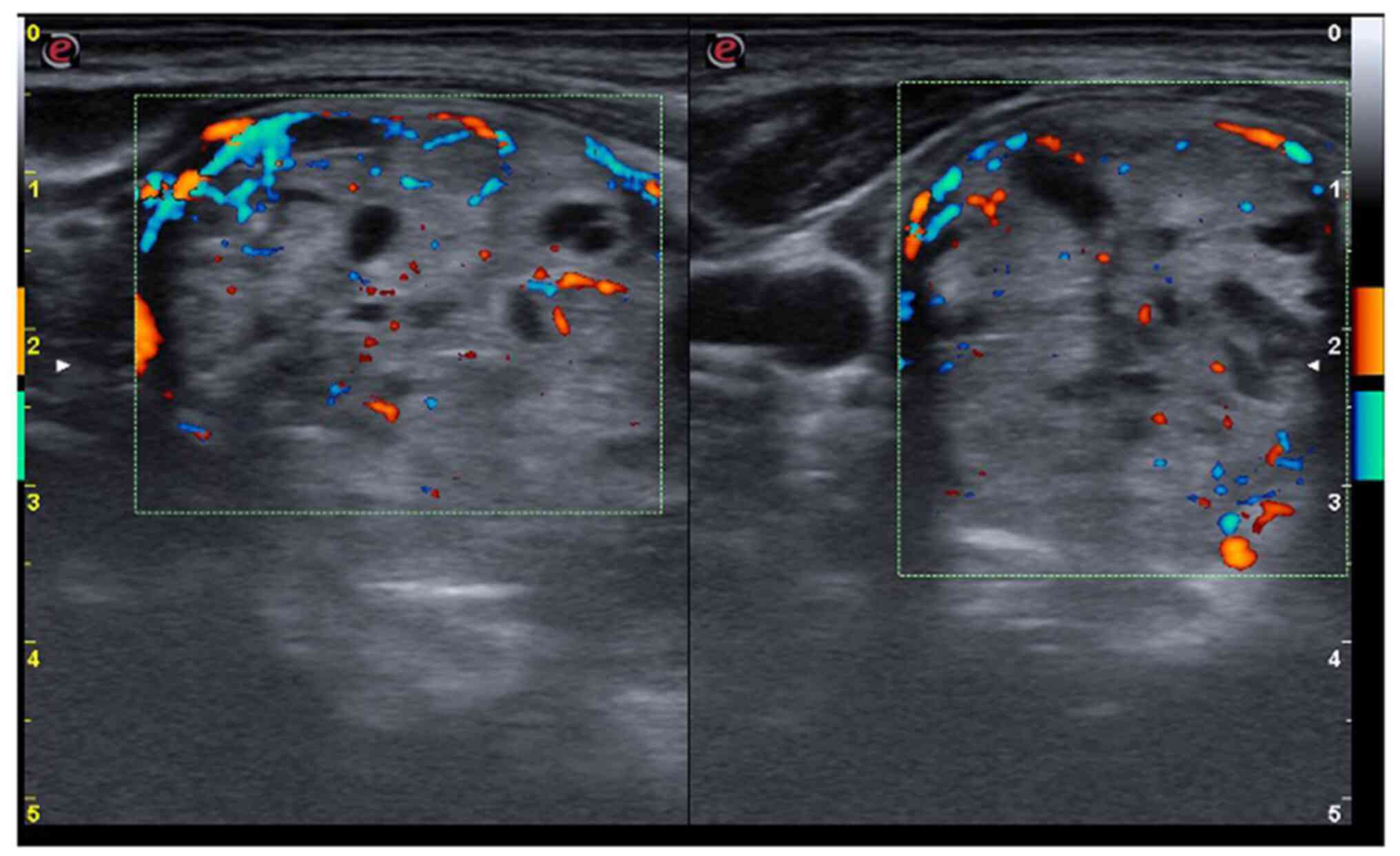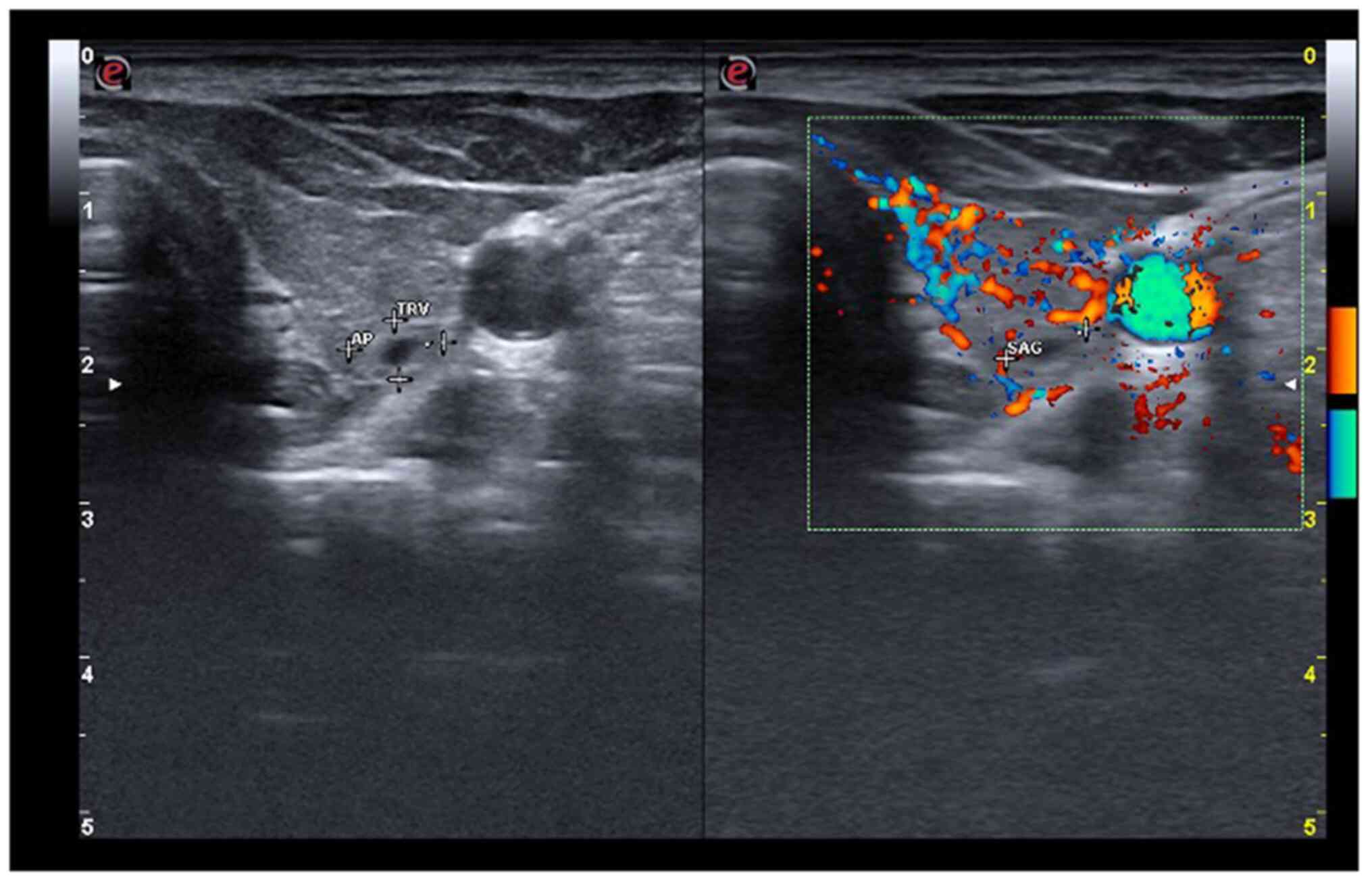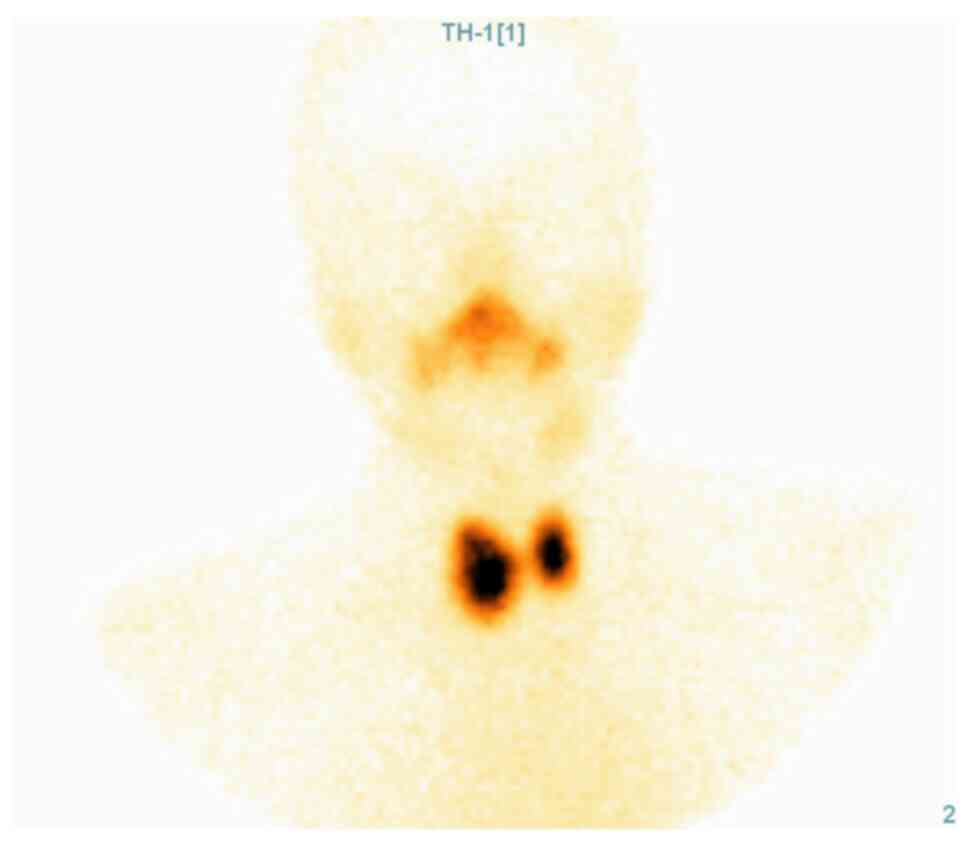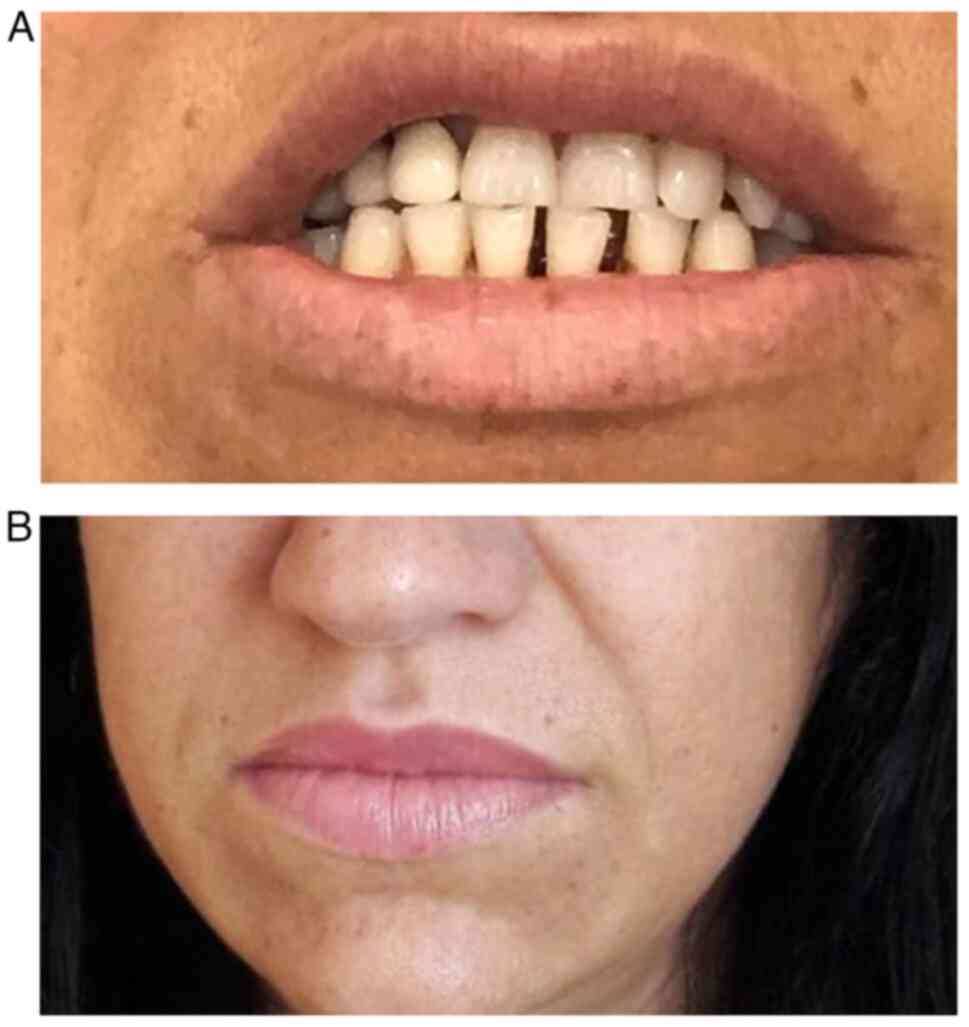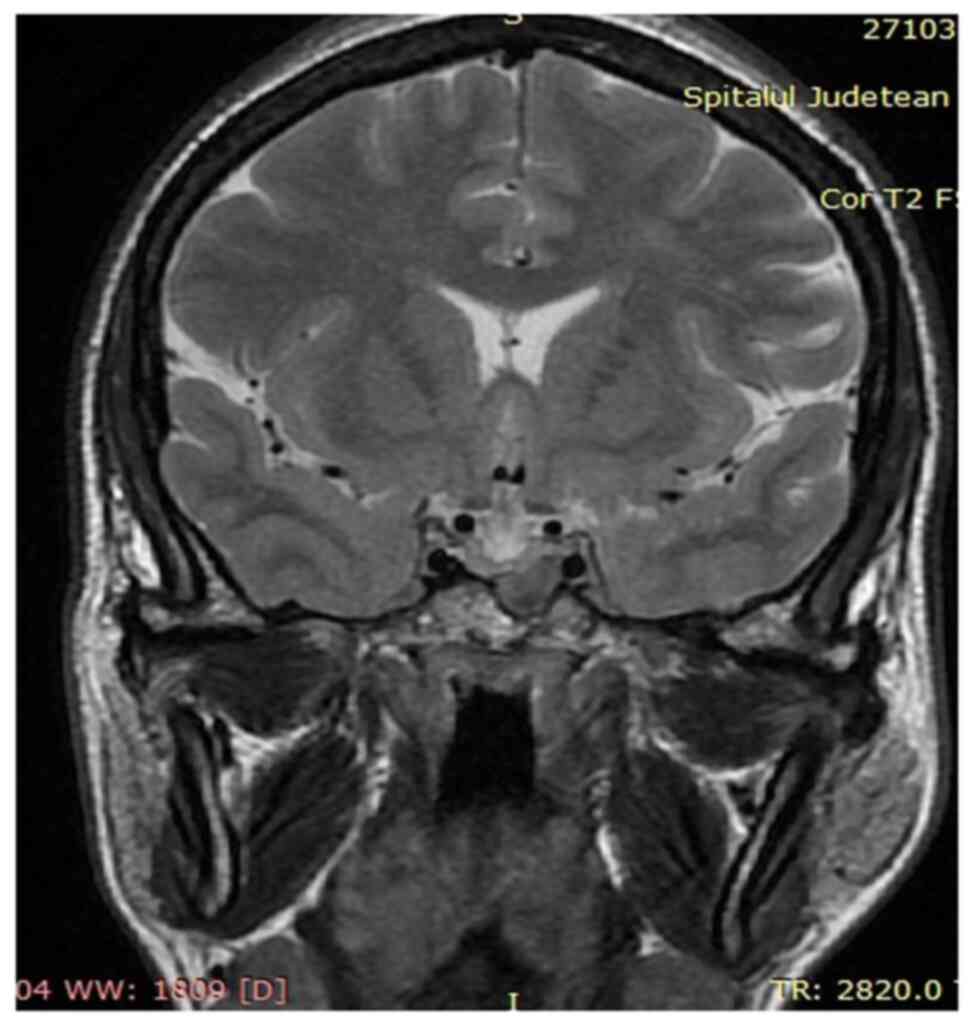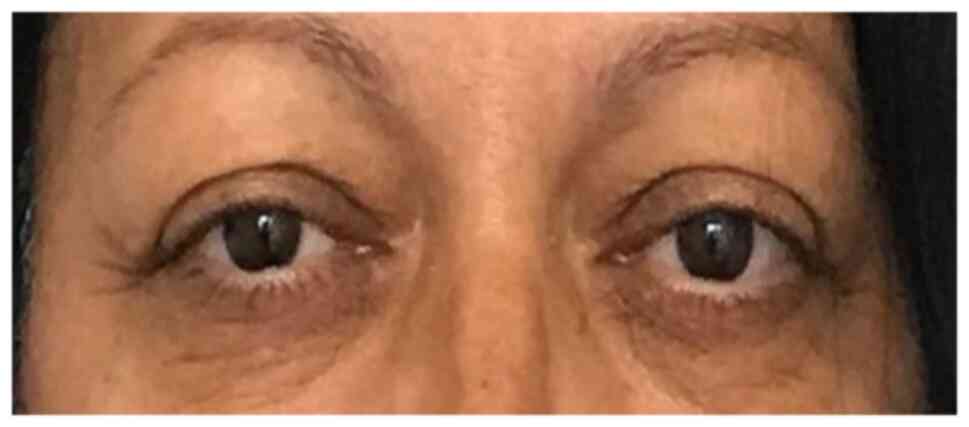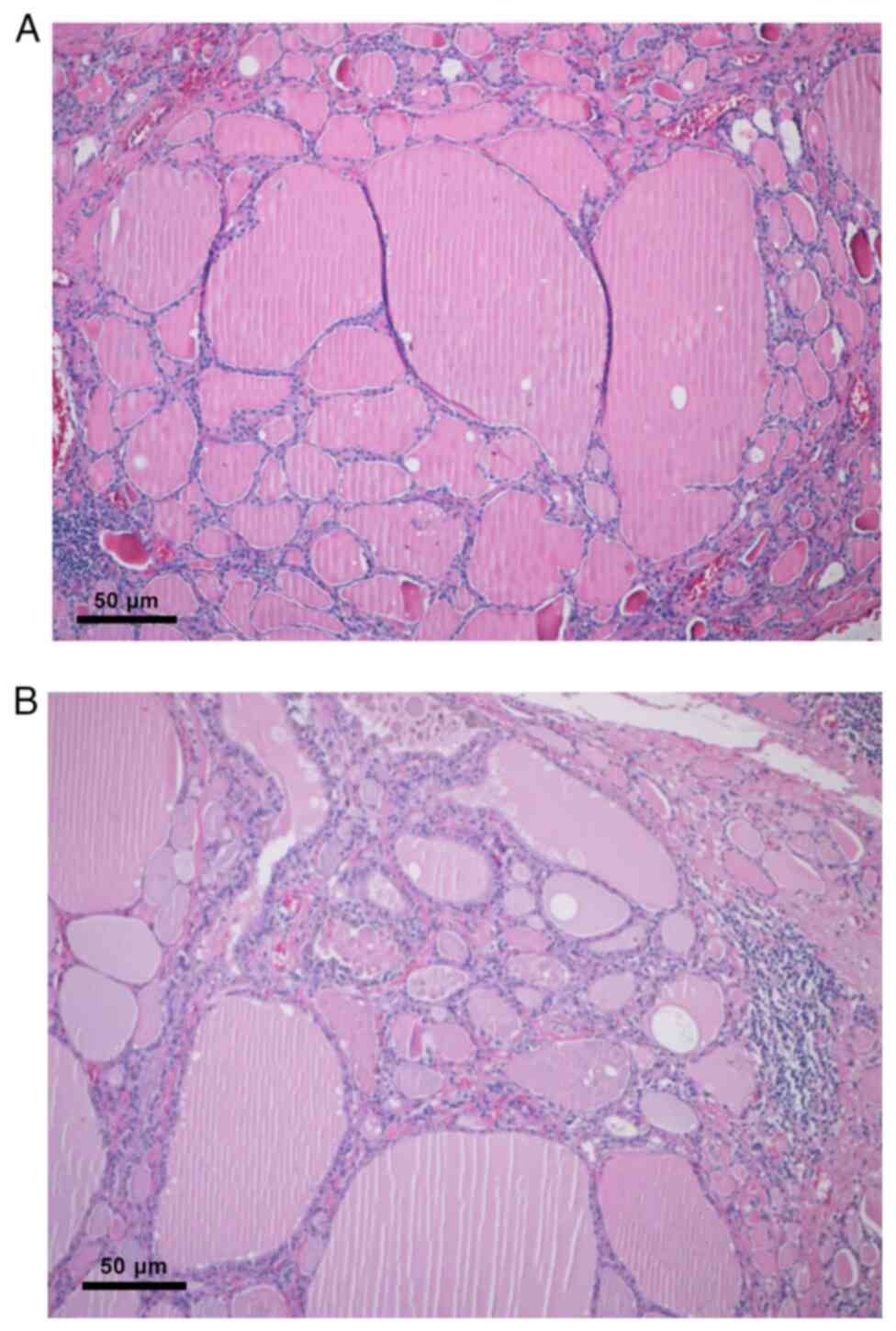A rare form of hyperthyroidism leading to the diagnosis of acromegaly: A case report
- Authors:
- Published online on: August 22, 2023 https://doi.org/10.3892/etm.2023.12176
- Article Number: 477
-
Copyright: © Plotuna et al. This is an open access article distributed under the terms of Creative Commons Attribution License.
Abstract
Introduction
Acromegaly is a rare disease, usually caused by a pituitary tumor secreting growth hormone (GH), that has an annual incidence rate between 0.2 and 1.1 cases per 100,000 individuals (1). Given the clinical features associated with this pathology develop insidiously, the delay between onset and diagnosis can be >5 years (2). Numerous comorbidities are associated with exposure to high levels of GH and its peripheral mediator, insulin-like growth factor 1 (IGF-1).
Goiter is a frequent endocrine comorbidity of acromegaly. It is the result of overstimulation by GH and IGF-1 of the follicular epithelium (3,4). Diffuse and nodular goiter represent ~57.7% of acromegaly cases, while toxic nodular goiter is an unusual occurrence in acromegalic patients, although it is more common in women (3,5). Usually, patients with acromegaly are euthyroid or develop central hypothyroidism due to the compressive nature of the tumor. Hyperthyroidism is diagnosed in 3.5-26% of acromegalic patients (3). Active acromegaly can impair thyroid-stimulating hormone (TSH) response to thyrotropin-releasing hormone (TRH), leading to abnormal TSH values, and increased conversion of free thyroxine (T4) to free triiodothyronine (T3), which results in central suppression of TSH secretion (6).
The association between acromegaly and thyroid autoimmunity was also shown previously; 25% of the patients, the majority of whom were women, had positive anti-thyroid peroxidase (ATPO) antibodies (7).
Autoimmune thyroid diseases (AITD) affect 2-5% of the population, being more commonly diagnosed in women, and these include Graves' disease among other pathologies (8,9). Clinical characteristics of Graves' disease are represented by hyperthyroidism, diffuse goiter, and Graves' ophthalmopathy (GO) (10). The primary clinical presentation of GO includes eyelid retraction and periorbital edema (11). Both signs may mimic soft tissue proliferation and coarsening of the facial features, characteristic of acromegaly (12). Other signs, such as increased sweating, heat intolerance, visual disturbances, and fatigue, are common both in hyperthyroidism and acromegaly (12). To summarize, a diagnosis of acromegaly may be overlooked, due to certain shared symptoms with Graves' disease.
Acromegaly and hyperthyroidism have distinct pathophysiological mechanisms and hormonal profiles; biological parameters, such as those related to phospho-calcium metabolism, exhibit similar changes between the two diseases (12). In acromegaly, higher serum phosphate (due to increased renal tubular resorption) and increased plasma calcium levels, together with hypercalciuria, most likely as a result of GH or IGF-I direct actions, are observed (12,13). Hyperthyroidism is also associated with a catabolic state that leads to bone resorption and hypercalcemia (14). High levels of serum calcium lower the levels of parathormone and, as a consequence, increased renal tubular reabsorption of phosphorus, leading to high levels of this electrolyte are observed (14).
The clinical case presented here describes the difficulties in diagnosing acromegaly due to its unusual association with two distinct thyroid pathologies.
Case report
A 47-year-old female patient was admitted to the Department of Endocrinology of the Emergency County Hospital Timisoara in October 2018, with the following symptoms: Hyperhidrosis, fatigue, paresthesia in the upper left limb, dyspnea, dysphagia, and a gritty sensation in the eyes accompanied by conjunctival edema and erythema.
The personal history of the patient revealed that she was diagnosed with subclinical hyperthyroidism in 2012 (etiology not mentioned) and was treated with antithyroid drugs for 4 years. At that time, she was also diagnosed with hypertension and received treatment with β-blockers and angiotensin-converting-enzyme inhibitors. In 2016, the patient underwent neck ultrasound and thyroid scintigraphy resulting in a diagnosis of toxic adenoma and was thus treated with radioactive iodine. Later that year she developed hypothyroidism, for which she was given levothyroxine until September 2018. Therapy was discontinued due to the lab results that revealed hyperthyroidism and the patient was transferred to the development of bilateral ophthalmopathy.
During the first admission to the Department of Endocrinology (October 2018), the clinical examination of the anterior cervical region revealed a palpable painless nodule of ~5 cm in the right lobe, which had increased consistency and was mobile while swallowing. The following abnormalities were also noted: Bilateral symmetric exophthalmos and increased blood pressure (160/80 mmHg).
The neck ultrasound detected a hypoechoic thyroid parenchyma with an increased volume of the thyroid (26.8 ml, upper normal limit <16 ml). The right lobe was completely replaced by a spongiform nodule, with increased vascularity (Fig. 1), which was classified as benign by ACR-TIRADS (score 2) (15). The left lobe exhibited increased vascularity and, close to the posterior capsule, there was a partially cystic nodule of 6/5/7 mm (Fig. 2), also classified as benign by ACR-TIRADS (score 2).
Laboratory tests confirmed that the patient presented subclinical hyperthyroidism, with low levels of TSH (0.025 mU/l; normal range, 0.55-4.78 mU/l) and normal levels of FT4 (14.93 pmol/l; normal range, 11.50-22.70 pmol/l), and FT3 (5.98 pmol/l; normal range, 3.54-6.47 pmol/l). Given the medical history of the patient and the morphological aspect of the right lobe, a thyroid scintigraphy was performed. It showed increased Tc99m-pertechnetate uptake in the right lobe, relative to the extra-nodular thyroid tissue, an aspect that confirmed the diagnosis of toxic adenoma (Fig. 3).
The presence of the bilateral ophthalmopathy and increased vascularity of the thyroid left lobe raised the suspicion of Graves' disease, thus the levels of anti-TSH receptor antibodies were measured; their high titer (>40 IU/l, normal values <1.75 IU/l) confirmed this diagnosis. The patient had normal values of ATPO antibodies (48 IU/ml; normal range, 0-60 IU/ml) and high levels of antithyroglobulin antibodies (>500 IU/ml; normal range, 0-60 IU/ml).
Other blood tests results were also abnormal: Fasting blood glucose=124 mg/dl (normal range, 70-109 mg/dl), glycated hemoglobin=6.1% (normal range, 4.36-5.6%), serum phosphate 5.8 and 6.1 mg/dl (tested twice; normal range, 2.5-4.9 mg/dl), serum magnesium 1.48 mg/dl (normal range, 1.8-2.4 mg/dl) and alkaline phosphatase 127 U/l (normal range, 46-116 U/l).
Given the fact that the patient denied the consumption of drugs containing phosphate, the normal renal function, and normal values of serum calcium, 25(OH)vitamin D, and parathormone, the most common causes of increased serum phosphate levels were excluded.
A more detailed history and targeted clinical exam were performed. They revealed the following: Macroglossia, increased interdental spaces (Fig. 4A), enlarged lips, and prominent nasolabial folds (Fig. 4B). The patient also mentioned she was not able to take off her wedding ring for ~5 years. The suspicion of acromegaly was raised and, consequently, IGF-1 (891 ng/ml, normal range for age and sex 83.3-220 ng/ml) and basal GH (20.2 ng/ml, normal value for age and sex <10 ng/ml) were determined. A suppression test with 75 g glucose administered orally was also performed, showing the failure to suppress GH below 1 ng/ml and thus confirming the diagnosis of acromegaly. The evaluation of the global function of the pituitary gland did not identify other hormonal deficiencies (prolactin=4 ng/ml, normal range=2.8-29.2 ng/ml; FSH=75.98 mIU/ml, normal range for menopause=23.0-116.3 mIU/ml; LH=43.05 mIU/ml, normal range for menopause=7.9-53.8 mIU/ml; estradiol <11.80 pg/ml, normal range for menopause <32.2 pg/ml; and cortisol=12.38 mcg/dl, normal range=4.3-22.4 mcg/dl). A pituitary MRI was performed to detect and characterize the adenoma. It revealed a macroadenoma (13/9 mm), hypointense compared to the normal pituitary parenchyma (in T2-weighted signal), which invaded the left sphenoid sinus, without imprinting the optic chiasm (Fig. 5).
To treat the hyperthyroidism, the patient was administered thiamazole 10 mg daily. Ophthalmopathy was classified according to the European guidelines (16) as active (clinical activity score, 3) and mild (Fig. 6). Consequently, a watchful strategy was implemented, and the patient received local treatment. Therapy of the pituitary pathology was prioritized and thyroid function and morphology were reassessed thereafter. Surgery was recommended and the patient was referred to the Neurosurgery Department.
The patient was readmitted to the Department of Endocrinology in March 2019, 12 weeks after surgery (transsphenoidal adenectomy). Lab tests revealed high levels of IGF-1 (474 ng/ml, normal range 81.8-219 ng/ml), high levels of basal GH (9.14 ng/ml, normal range 0.05-8 ng/ml), and lack of suppression of GH <1 ng/ml during an oral glucose test with 75 g glucose. MRI was performed and a residual tumor was identified in the sphenoid sinus. The disease was considered active and therapy with octreotide (a somatostatin analogue) 20 mg intramuscularly (IM) every 28 days was initiated. The level of serum phosphate was 4.5 mg/dl (normal range, 2.5-4.9 mg/dl). Blood glucose and glycated hemoglobin were normal, and the response to oral glucose (blood glucose at 120 min=87 mg/dl) were normal, as well.
The patient was screened for complications associated with acromegaly and was diagnosed with severe sleep apnea. The other screening tests were unremarkable. The patient did not present any gastrointestinal complications.
The re-evaluation of thyroid function revealed hypothyroidism (low TSH levels associated with low FT4 levels), thus thiamazole was discontinued (the last daily dose was 5 mg). The thyroid aspects in ultrasound and the status of the ophthalmopathy did not change.
In June 2019, 3 months after therapy with somatostatin analogues had been started, the patient was re-evaluated. Even though the clinical status improved (Fig. 7), the response to therapy was poor. Lab tests revealed high levels of IGF-1 (658 ng/ml, normal range 81.8-219 ng/ml), high levels of GH (8.49 ng/ml, normal range 0.05-8 ng/ml), and a lack of suppression of GH below 1 ng/ml during an oral glucose tolerance test; MRI remained unchanged. Taking into consideration the blood tests and the presence of the residual tumor, the dose of octreotide was increased (30 mg IM every 28 days) and cabergoline was added (2 mg orally every week).
The function and morphology of the thyroid were reassessed, showing mild subclinical hyperthyroidism, while the neck ultrasound was unchanged. The ophthalmological consultation classified the eye disease as inactive and moderate (clinical score activity=1/10, Fig. 8) (16). Due to the history the thyroid disease and the tracheal compression by the thyroid nodule (proven by radiological studies), the patient was referred to an endocrine surgeon for total thyroidectomy. After surgery, the evolution was favorable and therapy with levothyroxine was initiated. The pathological result confirmed the concurrence of two distinct thyroid diseases in addition to the degenerative changes induced by therapy, a hyperfunctioning goiter with pronounced degenerative changes, imprecisely contoured adenomatous nodules, with areas of hyalinization and interstitial calcification, cystic degeneration, and areas of angiomatosis primarily expressed in the right lobe of the thyroid (Fig. 9A and B).
The patient was re-evaluated periodically and, 9 months later, she was unresponsive to medical treatment. At this point, pegvisomant (up to 20 mg daily), was initiated which was well tolerated. After 6 months of therapy, IGF-1 was normal, and the clinical status of the patient improved significantly. The patient did not exhibit any adverse reactions, and the pituitary tumoral rest did not increase.
Discussion
Here, the case of an acromegalic patient, who was initially admitted to our department for hyperthyroidism, is described. After routine lab tests, acromegaly was suspected and confirmed thereafter by a dedicated workup. The etiology of hyperthyroidism was challenging due to the coexistence of both toxic adenoma and complicated Graves' disease. Secondary hypothyroidism was excluded due to the medical history of the patient, normal FT4 levels, positive anti-TSH receptor antibodies, thyroid ultrasound (thyroid volume was increased), and scintigraphy showing increased uptake in the right lobe (17,18).
As a result of the insidious evolution of acromegaly, its signs and symptoms may remain unnoticed for long periods of time. In our case, due to the concomitant thyroid pathology, certain aspects of the clinical exam that suggested a diagnosis of acromegaly in a patient who had no complaints related to tumoral compression (headache, blurred vision, or vomiting) were overlooked. During routine lab workouts, a high level of serum phosphorus, accompanied by normal calcium and parathormone values, leads to a more detailed anamnesis and physical exam. After asking questions that targeted the signs and symptoms of acromegaly, the diagnosis was considered more seriously. The association between acromegaly and Graves' disease is rare, but may be due to a series of clinical manifestations such as acral enlargement, soft tissue overgrowth, coarsening of facial features, and joint pain. If these manifestations are discrete or absent, as was described in the present case, the diagnosis can be challenging. In such situations, even a minimal biological change, such as hyperphosphatemia, should receive more attention.
Hyperphosphatemia is not uncommon among these patients, due to the increased tubular reabsorption of this electrolyte, given the action of IGF-1 on the apical membrane sodium-phosphate IIa cotransporters (19). It was hypothesized that phosphate may reflect the status of acromegaly, but in patients with preoperative serum phosphate >4.5 mg/dl, no correlation was found (20). Nevertheless, its decrease after 3 months may predict remission in patients with discordant GH and IGF-1 values (20). Conversely, a study published in 2017 revealed that hyperphosphatemia at diagnosis was more common in patients who had an active disease after therapy (21).
Acromegaly is a rare disease; however, its association with thyroid pathology is not uncommon (3). Nevertheless, the coexistence of Graves' disease and acromegaly has a very low prevalence (<1%) (22). IGF-1 has a synergic effect with TSH on thyroid cell proliferation and may mediate an immunological response by stimulating the proliferation of T cells and B cells, while GH might stimulate the production of TSH receptor antibodies (22). All these mechanisms play a role in thyroid growth and can influence the severity of Graves' disease.
The presence of both toxic adenoma and Graves' disease (Marine-Lenhart syndrome) is a very rare occurrence, with a prevalence of 1-2.5% (23), and their association with acromegaly has not previously been reported in the literature, to the best of our knowledge. Given the fact that the patient did not undergo a full medical check-up prior to being referred to our department, it was suggested that the radioiodine therapy may have induced Graves' disease (24). A study that included 191 patients with nontoxic goiter treated with 131I found that 5% of the patients developed hyperthyroidism without eye involvement after 3 months of therapy, and this was more frequent in those who had elevated ATPO antibody levels. The suggested mechanism that induced autoimmunity was the release of antigens from the follicular cells (25). A retrospective study in patients treated with 131I for toxic nodular goiter reported a prevalence of hyperthyroidism associated with high levels of anti-TSH receptor antibodies in 4% of the cases (26). Several risk factors are associated with hyperthyroidism, such as genetic predisposition and high levels of ATPO antibodies before therapy (25). In our patient, titers of ATPO antibodies were not evaluated before 131I therapy, but they were increased when they were measured during the first hospital admission. In addition, the patient had high levels of antithyroglobulin antibodies, thus this type of antibody as a risk factor for developing an autoimmune disease in this case could not be excluded.
Orbitopathy is a known extrathyroidal complication of Graves' disease, with an estimated incidence of 16 cases in 100,000 women, usually being present at the onset of the disease (27). The patient in the present case report provided little to no information regarding the onset of her eye symptoms, thus we were not able to establish a timeline regarding its evolution. A study by Coutu et al (28) found that high levels of GH were associated with extraocular muscle enlargement, a situation that may have been present in our case. After pituitary surgery, the condition of our patient's eye disease improved, without specific medication, an aspect also mentioned in the aforementioned study.
Hypertension is a common complication of acromegaly, with a prevalence of 50% in patients with active disease (29). Its severity is related to the excess of GH and IGF-1, which cause expansion of plasma volume and increased systemic vascular resistance, leading to elevated diastolic blood pressure (29). Conversely, hypertension caused by hyperthyroidism is mostly due to increased systolic blood pressure as a result of renin release and sodium reabsorption (30). The patient in the present report had high blood pressure, most likely due to intricate mechanisms related to acromegaly and hyperthyroidism (stimulation of smooth muscle cell growth, increased arterial stiffness, renin release and sodium reabsorption) (29,30). Her blood pressure lowered, and the dosage of the oral medication was reduced after treating the acromegaly and hyperthyroidism.
Diagnosing and treating the patient, in this case, was a challenge. She did not respond to somatostatin analogues, even though she had predictors for a better evolution, such as being a female of childbearing potential and presenting a hypointense T2-weighted MRI signal of pituitary adenoma (31,32). There are several factors that can influence the response to somatostatin analogues, such as a lack of somatostatin receptors type 2 and 5, Ki-67 nuclear protein, or cytokeratin staining pattern (33). However, they could not be analyzed in the present case.
It has been noted that 25% of the patients do not respond to somatostatin analogues after 12 months (31). According to the current guidelines, our patient was completely unresponsive to therapy (34). Given the fact that her glucose metabolism was impaired before surgery and that she did not present any criterion for remission after the therapy with somatostatin analogues, we chose to initiate pegvisomant. ACROSTUDY showed that a dose of 18 mg/day was effective in 65% of patients treated with a GH receptor antagonist (35). In addition, complications associated with the treatment were very rare: 2.2% of patients reported local discomfort, lipoatrophy, or reversible lipohypertrophy; 3-5% had tumoral growth; and 9% presented liver enzyme abnormalities (34,35). In the present case, the patient responded well to the therapy and did not show any side effects.
Due to the presence of multiple endocrine pathologies associated with glandular hyperfunction, the presence of a genetic defect in G-protein-coupled receptors cannot be excluded. However, its more frequent association with congenital endocrine pathologies, as well as the absence of a particular phenotype of the patient, made this hypothesis unlikely (36).
In conclusion, acromegaly remains difficult to diagnose and treat, because it has a slow evolution and some of the clinical findings might be assigned to the patient's comorbidities. In such cases, all the clinical and biochemical abnormalities that may suggest a diagnosis of acromegaly should be considered.
Acknowledgements
Not applicable.
Funding
Funding: No funding was received.
Availability of data and materials
The datasets used and/or analyzed during the present study are available from the corresponding author on reasonable request.
Authors' contributions
MV, ISP, FV, MB, IG, AV, DA and MC collected, analyzed and interpreted the data. ISP, MB, IG, DA, AV, and MV wrote and critically revised the manuscript. All authors have read and approved the final manuscript. All authors agreed to be accountable for all aspects of the work. ISP, MV, IG, and AV confirm the authenticity of all the raw data.
Ethics approval and consent to participate
Not applicable.
Patient consent for publication
The patient provided written consent for the publication of their data.
Competing interests
The authors declare that they have no competing interests.
References
|
Crisafulli S, Luxi N, Sultana J, Fontana A, Spagnolo F, Giuffrida G, Ferraù F, Gianfrilli D, Cozzolino A, Cristina De Martino M, et al: Global epidemiology of acromegaly: A systematic review and meta-analysis. Eur J Endocrinol. 185:251–263. 2021.PubMed/NCBI View Article : Google Scholar | |
|
Esposito D, Ragnarsson O, Johannsson G and Olsson DS: Prolonged diagnostic delay in acromegaly is associated with increased morbidity and mortality. Eur J Endocrinol. 182:523–531. 2020.PubMed/NCBI View Article : Google Scholar | |
|
Dąbrowska AM, Tarach JS, Kurowska M and Nowakowski A: Thyroid diseases in patients with acromegaly. Arch Med Sci. 10:837–845. 2014.PubMed/NCBI View Article : Google Scholar | |
|
Vargas-Ortega G, Romero-Gameros CA, Rendón-Macias ME, Balcázar-Hernández L, Sosa-Eroza E, Mercado M, de Los Monteros-Sánchez ALE, Pérez-Aguilar B, Paredes-Manjarrez C, Reyes-Olhagaray FB, et al: Risk factors associated with thyroid nodular disease in acromegalic patients: A case-cohort study in a tertiary center. Growth Horm IGF Res. 60-61(101431)2021.PubMed/NCBI View Article : Google Scholar | |
|
Natchev E, Vandeva S, Kovatcheva R, Kirilov G, Kalinov K and Zacharieva S: Thyroid gland changes in patients with acromegaly. Arch Endocrinol Metab. 64:269–275. 2020.PubMed/NCBI View Article : Google Scholar | |
|
Tirosh A and Shimon I: Complications of acromegaly: Thyroid and colon. Pituitary. 20:70–75. 2017.PubMed/NCBI View Article : Google Scholar | |
|
Manavela M, Vigovich C, Danilowicz K, Juri A, Miechi L, Fernandez Valoni V and Bruno OD: Thyroid autoimmune disorders in patients with acromegaly. Pituitary. 18:912–915. 2015.PubMed/NCBI View Article : Google Scholar | |
|
Franco JS, Amaya-Amaya J and Anaya JM: Thyroid disease and autoimmune diseases. In: Autoimmunity: from bench to bedside. Anaya JM, Shoenfeld Y, Rojas-Villarraga A, et al (eds). El Rosario University Press, Bogota, pp537-562, 2013. | |
|
Stanciu M, Bera LG, Popescu M, Grosu F and Popa FL: Hashimoto's thyroiditis associated with thyroid adenoma with Hürthle cells-case report. Rom J Morphol Embryol. 58:241–248. 2017.PubMed/NCBI | |
|
Pokhrel B and Bhusal K: Graves' Disease. In: StatPearls [Internet]. StatPearls Publishing, Treasure Island, FL, pp4-5, 2022. | |
|
Bahn RS: Graves' ophthalmopathy. N Engl J Med. 362:726–738. 2010.PubMed/NCBI View Article : Google Scholar | |
|
Gardner DG and Shoback D: Greenspan's Basic and Clinical Endocrinology. 10th edition. McGraw Hill Medical, New York, NY, pp69-120, 2017. | |
|
Halse J and Haugen HN: Calcium and phosphate metabolism in acromegaly. Acta Endocrinol (Copenh). 94:459–467. 1980.PubMed/NCBI View Article : Google Scholar | |
|
Mosekilde L and Christensen MS: Decreased parathyroid function in hyperthyroidism: Interrelationships between serum parathyroid hormone, calcium-phosphorus metabolism and thyroid function. Acta Endocrinol (Copenh). 84:566–575. 1977.PubMed/NCBI View Article : Google Scholar | |
|
Tessler FN, Middleton WD, Grant EG, Hoang JK, Berland LL, Teefey SA, Cronan JJ, Beland MD, Desser TS, Frates MC, et al: ACR thyroid imaging, reporting and data system (TI-RADS): White paper of the ACR TI-RADS Committee. J Am Coll Radiol. 14:587–595. 2017.PubMed/NCBI View Article : Google Scholar | |
|
Bartalena L, Kahaly GJ, Baldeschi L, Dayan CM, Eckstein A, Marcocci C, Marinò M, Vaidya B and Wiersinga WM: EUGOGO†. The 2021 European Group on Graves' orbitopathy (EUGOGO) clinical practice guidelines for the medical management of Graves' orbitopathy. Eur J Endocrinol. 185:G43–G67. 2021.PubMed/NCBI View Article : Google Scholar | |
|
Bel Lassen P, Kyrilli A, Lytrivi M and Corvilain B: Graves' disease, multinodular goiter and subclinical hyperthyroidism. Ann Endocrinol (Paris). 80:240–249. 2019.PubMed/NCBI View Article : Google Scholar | |
|
Persani L: Clinical review: Central hypothyroidism: Pathogenic, diagnostic, and therapeutic challenges. J Clin Endocrinol Metab. 97:3068–3078. 2012.PubMed/NCBI View Article : Google Scholar | |
|
Jehle AW, Forgo J, Biber J, Lederer E, Krapf R and Murer H: IGF-I and vanadate stimulate Na/Pi-cotransport in OK cells by increasing type II Na/Pi-cotransporter protein stability. Pflugers Arch. 437:149–154. 1998.PubMed/NCBI View Article : Google Scholar | |
|
Xie T, Tian P, Wu S, Zhang X, Liu T, Gu Y, Sun C and Hu F: Serum phosphate: Does it more closely reflect the true state of acromegaly? J Clin Neurosci. 71:26–31. 2020.PubMed/NCBI View Article : Google Scholar | |
|
Yalin GY, Tanrikulu S, Gul N, Uzum AK, Aral F and Tanakol R: Utility of baseline serum phosphorus levels for predicting remission in acromegaly patients. J Endocrinol Invest. 40:867–874. 2017.PubMed/NCBI View Article : Google Scholar | |
|
Di Cerbo A, Pezzuto F and Di Cerbo A: Growth hormone and insulin-like growth factor 1 affect the severity of Graves' disease. Endocrinol Diabetes Metab Case Rep. 2017:17–0061. 2017.PubMed/NCBI View Article : Google Scholar | |
|
Ribeiro F, Ruas L, Júnior A, Sousa A, Araújo A, Mwambire J, Jesus A, Bussuan R, Sá L and Arbex A: Graves' disease and Marine Lenhart syndrome: A rare clinical presentation. Health. 11:1169–1176. 2019. | |
|
Shen G, Cui F, Huang R and Kuang A: Graves' disease following radioiodine therapy for toxic adenoma: Clinical case report. Medicine (Baltimore). 96(e8550)2017.PubMed/NCBI View Article : Google Scholar | |
|
Nygaard B, Knudsen JH, Hegedüs L, Scient AV and Hansen JE: Thyrotropin receptor antibodies and Graves' disease, a side-effect of 131I treatment in patients with nontoxic goiter. J Clin Endocrinol Metab. 82:2926–2930. 1997.PubMed/NCBI View Article : Google Scholar | |
|
Nygaard B, Faber J, Veje A, Hegedüs L and Hansen JM: Transition of nodular toxic goiter to autoimmune hyperthyroidism triggered by 131I therapy. Thyroid. 9:477–481. 1999.PubMed/NCBI View Article : Google Scholar | |
|
Lazarus JH: Epidemiology of Graves' orbitopathy (GO) and relationship with thyroid disease. Best Pract Res Clin Endocrinol Metab. 26:273–279. 2012.PubMed/NCBI View Article : Google Scholar | |
|
Coutu B, Alvarez DA, Ciurej A, Moneymaker K, White M, Zhang C and Drincic A: Extraocular muscle enlargement in growth hormone-secreting pituitary adenomas. AJNR Am J Neuroradiol. 43:597–602. 2022.PubMed/NCBI View Article : Google Scholar | |
|
Ramos-Leví AM and Marazuela M: Bringing cardiovascular comorbidities in acromegaly to an update. How should we diagnose and manage them? Front Endocrinol (Lausanne). 10(120)2019.PubMed/NCBI View Article : Google Scholar | |
|
Prisant LM, Gujral JS and Mulloy AL: Hyperthyroidism: A secondary cause of isolated systolic hypertension. J Clin Hypertens (Greenwich). 8:596–599. 2006.PubMed/NCBI View Article : Google Scholar | |
|
Colao A, Auriemma RS, Lombardi G and Pivonello R: Resistance to somatostatin analogs in acromegaly. Endocr Rev. 32:247–271. 2011.PubMed/NCBI View Article : Google Scholar | |
|
Puig-Domingo M, Resmini E, Gomez-Anson B, Nicolau J, Mora M, Palomera E, Martí C, Halperin I and Webb SM: Magnetic resonance imaging as a predictor of response to somatostatin analogs in acromegaly after surgical failure. J Clin Endocrinol Metab. 95:4973–4978. 2010.PubMed/NCBI View Article : Google Scholar | |
|
Ezzat S, Caspar-Bell GM, Chik CL, Denis MC, Domingue MÈ, Imran SA, Johnson MD, Lochnan HA, Grégoire Nyomba BL, Prebtani A, et al: Predictive markers for postsurgical medical management of acromegaly: A systematic review and consensus treatment guideline. Endocr Pract. 25:379–393. 2019.PubMed/NCBI View Article : Google Scholar | |
|
Katznelson L, Laws ER Jr, Melmed S, Molitch ME, Murad MH, Utz A and Wass JA: Endocrine Society. Acromegaly: An endocrine society clinical practice guideline. J Clin Endocrinol Metab. 99:3933–3951. 2014.PubMed/NCBI View Article : Google Scholar | |
|
van der Lely AJ, Biller BM, Brue T, Buchfelder M, Ghigo E, Gomez R, Hey-Hadavi J, Lundgren F, Rajicic N, Strasburger CJ, et al: Long-term safety of pegvisomant in patients with acromegaly: Comprehensive review of 1288 subjects in ACROSTUDY. J Clin Endocrinol Metab. 97:1589–1597. 2012.PubMed/NCBI View Article : Google Scholar | |
|
Fukami M, Suzuki E, Igarashi M, Miyado M and Ogata T: Gain-of-function mutations in G-protein-coupled receptor genes associated with human endocrine disorders. Clin Endocrinol. 88:351–359. 2018.PubMed/NCBI View Article : Google Scholar |



